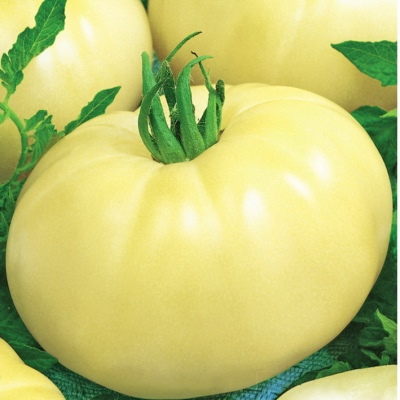
- Category: grade
- Growth type: semi-determinant
- Appointment: fresh consumption, for pickling and preserving
- Ripening period: mid-early
- Ripening time, days: 90-120
- Growing conditions: for open ground, for film greenhouses
- Bush size: medium-sized
- Bush height, cm: 140-150
- Ripe fruit color: creamy white
- Fruit shape: flat-round
The Creme brulee variety immediately attracts with the exotic color of the fruit. The group of tomatoes with white, creamy, creamy yellow tomatoes is gradually becoming more and more popular, today there are at least 2 dozen varieties. The Creme brulee variety was bred in Russia, included in the State Register in 2017.
Description of the variety
Tomato Creme brulee is a semi-determinate variety. This category of varieties is most popular with gardeners. Such varieties have the ability to grow indefinitely and at the same time can be quite compact. You do not need to grow a tomato under 2 meters in order for it to realize its yield potential.
Plants of Creme brulee tomatoes grow to 140-150 cm. The foliage is medium in size. The fruits are collected in small clusters, from 3 to 5 pcs.
The main qualities of the fruit
Fruits of an unusual color - light vanilla, really, resemble creme brulee ice cream. The size is quite large - 160-250 grams, the shape is massive, flat-round, slightly ribbed. Inside the fruit are many small chambers with juice. The main part of the tomato is a juicy pulp of a delicate lemon shade, in the context of a tomato it resembles an exotic fruit. The skin is thin, it seems translucent, but it is dense, moderately glossy, elastic, not prone to cracking. The fruits lie well, do not spoil for a long time, and are easy to transport.
Taste characteristics
The taste is delicate, delicate, fruity, soft notes of melon are felt. Creme brulee tomatoes are suitable for fresh dishes: appetizers, salads, cocktails, desserts. Perfect for table decoration, they look unusual and decorative. They are very good in blanks, cut and even whole.
The special nutritional value of white-fruited tomatoes should be taken into account. They do not contain oxalic acid, which provides them with special tenderness. And also the pigments anthocyanin and lycopene, which is great news for people prone to allergies. At the same time, white tomatoes contain a lot of sugars, which makes their taste sweet and unusual. Such tomatoes are recommended for people with various gastrointestinal diseases. They also strengthen blood vessels, immunity and the nervous system. They are very good in baby and diet food.
Ripening and fruiting
Ripens in medium terms. However, the first harvest can be obtained in May. Depends on the timing of sowing seeds for seedlings. On average, the yield falls on June-July. It is necessary to harvest white-fruited tomatoes on time, the longer the fruit stays in the sun, the more yellow it will be. If in doubt, tomatoes are harvested a little unripe, such tomatoes are slightly greenish at the base.
Yield
The tomato yield is average - 8-9 kg per 1 sq. m. This figure was obtained in film greenhouses.
The timing of planting seedlings and planting in the ground
Seedlings are sown at standard dates: from March to April, depending on the region. To obtain an earlier harvest, early sowing with supplementary lighting is recommended. Seedlings dive at the stage of 2-3 true leaves, carefully monitor the absence of flowers until the plant is planted in a permanent place. If they appear, they are cut off. They are planted in the ground either in May or in June - for Siberia and the Far East.

Growing tomato seedlings is an extremely important process, because it largely depends on whether the gardener can harvest at all. All aspects must be taken into account, from seedbed preparation to planting in the ground.
Landing scheme
The bush of the Crème brulee variety is medium in size, therefore, it is kept in the aisles of 60 cm, between the plants - 40 cm.

Growing and care
The variety is universal, suitable for growing both in greenhouses and in the open field.
Mandatory garter and removal of stepsons. Form into 2 stems. The rest of the plant is unpretentious and hardy, it needs the usual care for any tomatoes: timely watering, if the summer is too dry, but with the obligatory drying of the soil between waterings, top dressing for better yield and fruit quality.




A plant needs different micronutrients at each stage of growth. All fertilizers can be divided into two groups: mineral and organic. Folk remedies are often used: iodine, yeast, bird droppings, eggshells.
It is important to observe the rate and period of feeding. This also applies to folk remedies and organic fertilizers.


Review overview
There are few reviews about the variety. Confusing is the presence of the eponymous variety Creme brulee from the Aelita-Agro company, which has chocolate brown fruits. White-fruited Creme brulee is produced by Gavrish. He deserved only positive marks: very tasty and unpretentious, even in an unstable summer it shows itself, ties and gives away fruits. Does not get sick when changing heat and cold, although tomatoes are a crop that is sensitive to temperature fluctuations. But this variety fully fulfills the manufacturer's promise.Tomato is popular with those who love unusual preparations, exotic salads, are creative in cooking and want to impress their guests. The variety is not very productive, therefore it is not suitable for commercial cultivation, although it looks quite fertile in plantings. Lovers of classic tomatoes criticize the variety for its pale, implicit color, and too delicate indistinguishable taste. There are also prejudices against white-fruited tomatoes: they seem unripe and tasteless, so they are tried with caution. After a live tasting, conservative gardeners change their minds: the taste, although not typically tomato, is pleasant, refreshing, without harsh acid.

























































































